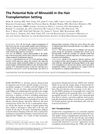Minoxidil hairs not growing to full length Minoxidil 5/15/2025
New hair growth from minoxidil and finasteride is not reaching full length, possibly due to slow growth cycles. Users discuss dosing strategies for oral minoxidil to improve efficacy and minimize side effects, with advice against consuming topical minoxidil orally.
View this post in the Community →
Similar Community Posts Join
5 / 1000+ resultscommunity 10 months on fin and hairline destroyed.
A user experienced severe hair shedding and hairline recession after 10 months on finasteride. They are considering switching to dutasteride or adding minoxidil.
community Micro needling 25 days progress. I’ve been on fin and min for 6 months but micro needling has done SO much more to actually restore my hairline
A user shared a 25-day progress picture showing significant hairline restoration attributed to microneedling, in addition to using minoxidil and finasteride for 6 months. Other users discussed needle length, frequency, and whether the effects of microneedling are permanent.
community 3 months of minoxidil foam. No fin or derma rolling
This user has had success with Minoxidil foam, achieving significant hair growth in three months without using finasteride or derma rolling. They are considering incorporating a DHT reducing strategy such as finasteride in the future.
community Is there any point to microneedling if you're on oral minoxidil?
Microneedling's effectiveness for hair regrowth is debated, with mixed results from studies. Some believe it helps with blood flow and scalp health, while others see it as largely ineffective.
community Hairfall is happening after 6 month of treatment and doctor doesn't give a F
User experienced major hair fall after six months of using minoxidil, finasteride, and dutasteride. Replies suggest the hair shedding is normal and will improve over time.
Related Research
6 / 1000+ results
research Treatments for Androgenetic Alopecia and Alopecia Areata
Minoxidil and finasteride treat hair loss; more research needed for other options.

research Technological Advances in Anti-Hair Loss and Hair Regrowth Cosmeceuticals: Mechanistic Breakthroughs and Industrial Prospects Driven by Multidisciplinary Collaborative Innovation
Collaboration and innovation are key to developing effective, safe hair loss treatments.

research Female Pattern Alopecia: Current Perspectives
Female pattern hair loss is caused by multiple factors and while treatments like topical minoxidil, hormone therapy, and low-level light therapy can help, none can fully cure it.

research Pathophysiology, Conventional Treatments, And Evidence-Based Herbal Remedies Of Hair Loss With A Systematic Review Of Controlled Clinical Trials
Herbal remedies may help with hair loss but need more research.

research Experimental and Early Investigational Drugs for Androgenetic Alopecia
New hair loss treatments may include topical medications, injections, and improved transplant methods.

research The Potential Role of Minoxidil in the Hair Transplantation Setting
Minoxidil can increase hair density, speed up regrowth in transplanted hair, and slow down further hair loss, especially beneficial for women, young men with thinning hair, and those wanting to reconstruct the back of the scalp.